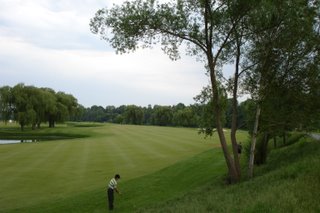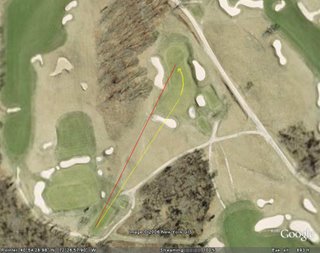Galt Country Club and The Valley Holes

The 185 yard par three 16th, with the tees and green set at the height of the protective levee.
On Thursday I attended the 100th Anniversary of Galt Country Club. It was a wonderful day, where I finally got a chance to play the new holes AI had built a year previous. I was asked to speak to the media and members and this was approximately my speech. Thought you may find the whole thing interesting.
Galt can be best described as a course where the scorecard does not mean a thing. It is a course where position and accuracy are rewarded over length and brawn. I have always enjoyed the opportunity to introduce the course to anyone who hasn’t played there. I’m used to people checking the card and saying “let’s play all the way back”, and “this should be a good opportunity to shoot a low score” I always chuckle and smile knowing the last comment they will make is “this course is harder than I thought”.
I have a long love affair with this course, from the very first time I was invited out to play. I love the way it sets into the landscape and I enjoy the ease in which you can get around the course. I love the fact I can not score here, but I think I should. I admire how so much great golf is placed into such a small package, a testament to a series of architects before me and Doug, Percy Barrett, Stanley Thompson and Bob Moote. I have been fortunate to work with the club and Mark Piccolo for a long time. We have done a lot of small things for a lot of years. A little bunker work, added some additional tees and even rebuilt a the 7th green along the way but I don’t think we really changed much of the character of the course.
The 15th, with the new water course on the left, the fairway at the levee height and the river on the right of the second landing.
A couple years ago we were faced with a project that would change the nature and character of the course. The Valley holes had become an increasing problem over the years and were out of play so often that something needed to be done. The decision was made to raise the holes, so that all playing areas were out of the 100 year flood. Easier said than done, the restrictions and negotiations with the Conservation Authority to get this approved were very trying, but perseverance from the club and Merv Redmond in particular helped finally obtain our approvals. The reason there is so much water on the Valley holes was simply to balance cut and fill in the valley and to provide enough long term water storage for the club. The technical aspect of the project dictated the design a lot.
The original three holes were very open and mildly interesting holes but had no relationship to the Grand River. The architectural vision for the Valley Holes was to try including the Grand River as a key part of the design. The trees were cut down along the Grand River and the holes were raised so that the 15th and 16th felt like the River was in play along both holes. I knocked it in the river on my first play of the new 16th hole, a place I had never been before!
We opened up spectacular views down the river which improved the overall feel of the holes. The club now had a view up the grand on the 14th and down the Grand on the 16th. The water on the interior represents the water course that once flowed through the holes when it was an island. The original concept was to allow the river to flow through once













